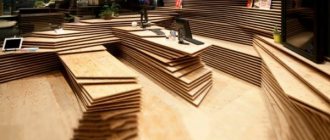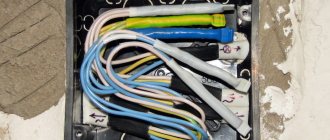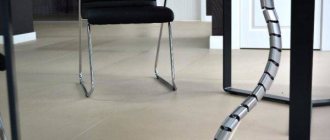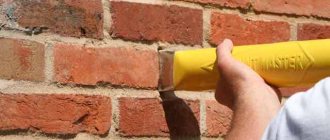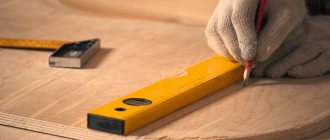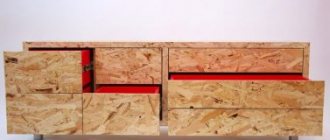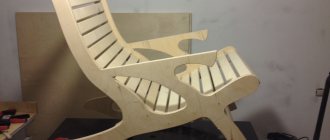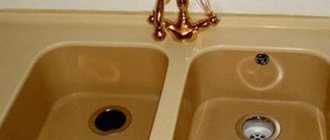In order to make plywood, well-dried sheets of peeled veneer are used. During the manufacturing process, these veneer sheets are connected to each other with a special adhesive composition, resulting in a very rigid and durable panel. Despite the fact that wooden products began to be used a very long time ago, plywood can rightfully be called a relatively new material, which began to be produced on a mass scale in the middle of the 19th century.
Plywood is a universal, moisture-resistant, durable, bendable material used in many areas of life.
The properties of this material allow it to be used for frame structures and interior decoration. After a waterproof adhesive was developed in the 1930s and used to make plywood, the sheets began to be used in almost the entire construction industry.
It is worth noting that plywood is divided into two types depending on the adhesive composition used. FSF is a variety with a high level of moisture resistance; phenol-formaldehyde resins are used for its production. The second type of material is FC, the main property is moisture resistance, gluing of sheets is carried out using urea-formaldehyde resins.
Plywood grades - classification by type of adhesive composition
The performance properties of plywood largely depend on the substance used for gluing the sheets. The quality of impregnation affects the moisture resistance and environmental friendliness of plywood, as well as its ability to withstand temperature fluctuations, humidity and other external influences. Based on the adhesive components used in production, many grades of plywood are distinguished.
FBA plywood
FBA is the least resistant material to a humid environment. However, the use of albumin casein glue makes it absolutely safe from an environmental point of view. This plywood is only suitable for rooms with low humidity levels. In particular, it has found its application in the production of furniture, and is also used to create all kinds of decorative interior elements.
Plywood FC
FC is a material with fairly low moisture resistance. The function of the binder in this case is performed by urea glue, which does not emit harmful substances, which allows this type of plywood to be used for finishing work inside residential premises. A moderate level of humidity is allowed.
FKM plywood
FKM – veneer sheets joined together using melamine glue. In terms of moisture resistance, the material is average.
Plywood FSF
FSF are especially durable wood boards, the layers of which are impregnated with phenol-formaldehyde resin. The material is able to withstand significant loads and resist moisture. However, the amount of toxins contained in the adhesive makes it possible to use such plywood exclusively outside the premises. In particular, it is ideal for cladding external walls in frame housing construction, erecting enclosing structures, and making outdoor furniture.
FB plywood
FB is a material in the production process of which bakelite glue is used. Sheets impregnated with this composition are characterized by increased moisture resistance and can withstand almost any temperature conditions. Impregnation reliably protects wood from negative environmental influences, which allows this type of plywood to be used in almost any area.
At the same time, FB-type boards may have characteristic differences, depending on the composition of the adhesive and sizing technology, which affects their characteristics.
Materials treated with alcohol-soluble impregnations are moisture resistant and are divided into three types:
- FBS is the highest quality plywood, each sheet of which is impregnated as thoroughly as possible;
- FBS1 – plywood boards, during the manufacturing process of which the method of coating veneer sheets is used, due to which the quality indicators of the material are reduced;
- FBS1A - belongs to the lowest class of bakelite plywood, in the production of which the amount of alcohol-soluble substance applied is limited, which involves processing exclusively longitudinally located sheets.
Another type is FBV plywood, in the manufacture of which water-soluble adhesive compositions are used.
There are two types of such plywood:
- Plywood, with the inner layers treated by the coating method, but the outer sheets impregnated.
- Plywood boards marked FBV1, for all layers of which only the coating method is assumed.
Advantages and disadvantages of such a solution
- Plywood is a fairly durable material, owing its parameters to the gluing of several layers together;
- The material is relatively environmentally friendly;
- The ability to compensate for even large differences in floor topography by creating an even frame of timber for the flooring;
- Wooden floors are warm, unlike concrete screeds. For this reason, this installation method should be chosen on the first floors;
- The design does not exert much pressure on the ceiling, unlike the screed, which can sometimes be filled with a large layer.
Important! The environmental friendliness of the floor is not complete, since plywood contains the toxic substance formaldehyde. It will not be possible to completely get rid of it, and therefore for interior decoration it is better to use a version containing 10 milligrams of this substance per 100 grams of weight.
- The disadvantage in this case is its susceptibility to moisture. The layered structure of plywood is not only an advantage, but also a disadvantage, since penetrating water can destroy the material;
- In the case of low ceilings, such a design may be unnecessary, since in this case the floor rises quite strongly;
- In the case of small differences in floor heights, it is easier and cheaper to pour a screed to correct the situation.
Plywood varieties
Today, GOST standards define five grades of plywood, differing in the presence of certain natural wood defects or those formed during its mechanical processing.
Grade E
Grade E is a high-quality elite material intended primarily for fine finishing. The presence of any foreign inclusions, as well as all kinds of deformations, is not allowed, with the exception of minor deviations in the structure of the wood, which are random. Pin knots on coniferous plywood are acceptable, but not more than 3 pieces per 1 m2. The aesthetic perfection of E plywood makes it the most expensive of all manufactured materials.
1st grade
1 – grade for which some defects in the form of knots, light porosity, repair inserts for sealing knots are acceptable. Such wood boards are used for both interior and exterior finishing work.
2nd grade
2 – grade of plywood, in which cracks up to 20 cm may be present, and the presence of small repair inserts for sealing knots, knots and wormholes, light and dark porosities is also allowed. It is permissible for glue to seep through in certain areas within 2% of the total area of the plywood sheet.
3rd grade
3 – grade of plywood, in many ways similar to the second grade, but here the restriction on the number of closed cracks and the number of knots of coniferous plywood has been removed. The maximum possible diameter of knots has been increased to 70 mm. In conditions of fine finishing, such defects can be hidden using special paints and varnishes.
4th grade
4 – grade, which includes the lowest quality and most affordable materials. Wood with numerous defects, including wormholes, as well as unjoined falling out knots, can be used in production. Uneven edges of glued sheets are allowed with deviations within 0.5 mm. The main purpose of such plywood is the production of packaging materials. However, it is often used for rough finishing indoors.
Preparatory stage
Any work, even the simplest one, is always preceded by a preparation stage. An important point is to clean the base where the logs will be laid from debris and dust. Then it is necessary to level the surface: if it becomes necessary to remove protrusions or cover up potholes and cracks.
After the above types of work, you can proceed to laying the waterproofing material. Roofing felt or polyethylene film can be chosen as waterproofing. Since these coatings are not super durable and the slightest pebbles can damage them, it becomes clear why it is important to carry out the preliminary steps for removing debris.
Waterproofing is laid in one layer overlapping each other. The overlap should be at least 20 cm on each side. To avoid lifting of the film as a result of its use, glue the joints with regular tape.
Important! To avoid breakouts, choose thick types of film or lay it in several layers.
Mark the floor for the installation sites for future logs. It is better to do this with a marker so that the lines are clear and do not get erased during the installation process. Prepare shims to control the height of the timber beam. To level their position, you will need a bubble or laser level. Also at the preparation stage, it is recommended to treat wooden building materials with antiseptic substances.
Advice! To clearly define the boundaries of the placement of plywood sheets relative to the guide joists, it is recommended to screw ordinary self-tapping screws on top. In addition, if you select fasteners of the required height, you can control the height and horizontal location of the logs.
Plywood by type of front surface
One of the parameters by which this material is classified is the technology used in production for processing the external surfaces of plywood. Based on this criterion, several types of plywood are distinguished.
1. Unsanded (NS) - the outer surface of the veneer is not subjected to additional processing, as a result of which it has a fairly rough structure. The risk of cracking increases. Mostly such materials are used for rough work, where the condition of the surface of the slabs is not of fundamental importance.
2. Ш1 – sanded plywood, processing of which is carried out on one side. Practically not prone to cracking.
3. Ш2 – material that is subjected to grinding on both sides. The ability to absorb moisture is minimized. As in the cases with Sh1 plywood, it can be used for finishing work, as well as in the manufacture of decorative products and individual structural elements of furniture.
4. Laminated plywood sheets , for the processing of which special resins are used that contain phenol and melamine. It is also relevant to apply PVC film to the surface of plywood. Thus, the moisture resistance of the material improves. Lamination allows you to extend the service life of wood boards. In addition, the external surface looks quite aesthetically pleasing. This type of plywood is often used in interior design.
We guarantee our customers:
- high quality of products presented in the catalogue;
- convenient forms of payment;
- possibility of purchasing in installments or on credit;
- discounts, promotions, sales;
- bonus cards for regular customers;
- fast delivery, etc.
Contact us and we will help you solve any problems related to repairs, construction, work in the garden or in the country.
Our hypermarket can be found both on the Internet and at the always valid address: Shchelkovsky district, 41st km of Shchelkovsky highway, no. 1. We work daily from 9:00 to 20:00, without breaks. Our professional consultants will help you with your choice.
Plywood for environmental safety
Since the production of wood-based panels uses a substance such as formaldehyde, a generally accepted scale has been developed that determines the level of permissible formaldehyde emissions. Based on the level of emission of harmful substances, plywood can be classified as class E1 or class E2.
E1 grade plywood
Class E1 includes materials that emit no more than 10 mg of harmful substances per 100 g of dry wood. Such indicators are considered acceptable for the use of plywood in residential premises.
E2 grade plywood
E2 class boards are recommended for use only for outdoor use, as the emission level can reach 30 mg.
At the same time, some unscrupulous manufacturers often indicate in the annotations to their products a class that does not correspond to reality. Using such materials in certain conditions is quite risky, so it is advisable to give preference to trusted manufacturers.
Information
For centuries, floors made from natural wood have been the traditional choice for all floors, with little choice in finishing materials.
About twenty or thirty years ago, no one could even think about how diverse the choice of flooring would be today, and with all this, wood flooring has turned into a layer for parquet or laminate.
Types of plywood according to the composition of raw materials
Based on the composition of raw materials, all plywood offered today can be divided into three categories.
Hardwood Plywood
The hardwood species from which plywood sheets are made primarily includes birch. The veneer made on its basis is characterized by increased density and uniformity of structure. At the same time, in comparison with other types of materials, strength indicators are higher on average by 20%. The only conditional disadvantage of birch plywood can be considered its cost, which is higher than that of coniferous plywood.
Slabs made from hardwood are in demand not only in private construction. These types of plywood are used as packaging elements for the transportation of goods, in the field of shipbuilding and carriage building, as well as in various areas of the automotive industry.
Softwood plywood
Coniferous wood is usually cheaper. Domestic manufacturers of such plywood mainly use pine, which has high strength indicators. The finished products are quite light, and the natural wood grain adds aesthetic appeal to them. Due to the presence of natural resin, the material has a longer service life. Coniferous plywood has found its application in house construction, and is also actively used in arranging the interiors of residential premises.
Combined plywood
Combined plywood sheets include both hardwood and softwood veneer. This combination allows you to reduce the cost of products, practically without compromising their quality, since the technical characteristics are as close as possible to sheets made from birch. This type of plywood is mainly in demand in the furniture industry.
Main advantages of OSB
OSB board has a lot of advantages, namely:
- high tensile, bending and shear strength due to the homogeneity of the structure, the absence of voids and weakened zones;
- moisture resistance - this property mainly depends on the composition of the glue. The presence of wax and resin in the structure of the material provides it with a relatively low swelling coefficient of the slab in a humid environment (17-25%);
- resistance to fungus and decay processes, which follows from the previous characteristic;
- excellent heat and sound insulation properties, which is why this material is used for the production of sandwich panels;
- light weight. OSB board, with the same volumes as plywood, weighs less. Therefore, it is easier to use and transport;
- smooth surface without knots, bumps, etc.;
- ease of processing. OSB board can be cut, sanded, painted, puttied, etc.;
- large selection of thicknesses and affordable prices.
Thus, we can conclude that plywood is a more environmentally friendly and visually attractive material. As for OSB boards, they are not afraid of moisture and are cheaper. Which of these properties is more important to the consumer, he decides for himself.
Types of plywood by purpose
Plywood boards are used not only in the construction of buildings and interior decoration. The scope of their application is much wider.
Furniture plywood
It is wear-resistant and also environmentally friendly. In most cases, this is a combined FC plywood, suitable for use in conditions of moderate humidity.
Construction plywood
Birch-based slabs are ideal for almost all types of rough finishing.
Formwork plywood
Thanks to its increased strength and moisture resistance, FB plywood is capable of being used in aggressive environments.
Decorative plywood
In the production of plywood intended for fine interior finishing, high-quality veneers are usually used. In this case, ideally smooth outer surfaces of the outer sheets are assumed, on which textured patterns are also visible.
Automotive plywood
FSF plywood is used to cover the body parts of trucks. The boards typically have a laminated or sometimes mesh-ribbed outer surface.
Marine plywood
In shipbuilding, there is quite a demand for moisture-resistant FB sheets, the production of which uses bakelite adhesives.
Flooring technology
- standard sheets measuring 125x125 cm are cut into four parts, which makes installation easier, reduces stress on the plywood, and increases the number of seams. These seams will compensate for possible deformation due to thermal or moisture expansion;
- prepared squares are laid out on the floor base and adjusted so that the gaps between the joining lines are at least 2 mm. The distance from the walls is up to 3 cm. The seams shift and the corners of the adjacent four sheets do not converge in one place;
- Each square, after adjustment, is numbered and they are all removed for final installation.
After laying the backing, the sheets are fastened with self-tapping screws to the boards so that four self-tapping screws form a square of 15x29 cm.
The concrete base must be primed with a special primer - paimer, which is made on the basis of the same glue or mastic that will be used for gluing plywood. Paimers have a high penetrating ability, due to which they make the top layer of concrete more durable and increase adhesion between the base and the adhesive.
After treatment with a paymer, they begin the process of laying plywood on the concrete floor:
- the base is covered with a layer of mastic/glue up to 2 mm using a notched trowel;
- in accordance with the diagram, sheets are attached;
- each square is fastened with self-tapping screws in increments of 20 cm. The screws are selected so that their length is 3 times greater than the width of the plywood. To ensure that the heads of the dowels for self-tapping screws do not protrude above the surface of the sheets, the concrete is pre-drilled at the places where they are fastened, a dowel is inserted into the hole and recessed completely into the recess.
In cases where it is not possible to make a screed, but it is necessary to significantly raise the floor level, additionally insulate it, lay communications, use logs on which plywood is laid. This process is the most labor-intensive, but it allows you to obtain high-quality flooring.
- The surface is pre-marked. At this stage, the height of the floor is determined and the layout of the joists is outlined. The optimal option for the location of the logs: corresponds to the size of the plywood squares, for example 30x30 cm, 30x60 cm, less often 60x60 cm;
- the height of the floor should take into account the possibility of laying insulation or communications, plumbing;
- wooden beams are used as lags, which are treated with a protective antiseptic composition;
- Regulating anchors are used to secure the logs. After they are established, the entire system is leveled using the building level;
- insulation is carried out with sheets of mineral wool or expanded clay. Mineral wool is easy to install and meets all the requirements for insulation;
- The elements are cut out as indicated above, but the location of the lags should be taken into account during preliminary layout. The sheets are joined on the joists and secured with self-tapping screws.
Plywood sheet sizes
The standard width of plywood sheets can be either 1220 or 1525 mm. The minimum length is 1525 mm, and the maximum reaches 2500 mm. Modern manufacturers mainly offer rectangular slabs with dimensions of 2440x1220mm, as well as square ones, for which the dimensions of the plywood sheet are 1525x1525mm. The exception is large-format products, for which the permissible length can reach 3050 mm.
Standard dimensions of plywood, mm.
1220x1220; 1525x1220; 1525x1525.
Large format plywood dimensions, mm.
1830x1525; 2440x1220; 2500x1250; 3000x1500; 3050x1525.
The thickness of plywood depends primarily on the number of layers. According to GOST requirements, there are regulated minimums and maximums - from 3 to 30 mm. At the same time, there are approved standards that allow some specialized enterprises to produce slabs with a thickness of 1 mm or more.
Video description
The video provides an overview of the comparison of plywood and OSB
Environmental friendliness
It is also more environmentally friendly than its popular analogue, if you take plywood with natural resins. If we compare it with the FSF, then there is virtually no difference between them.
Two types of fabric are made with the inclusion of chemicals.
It is impossible to make an unambiguous verdict regarding the harmfulness of the presented materials.
In the manufacture of OSB, many special chemical impregnations are used, thanks to which the boards acquired their special technical characteristics. As for plywood, almost all of its samples emit formaldehyde into the environment.
Ease of use
As for the features of plywood, they are easy to cut, but they generate a lot of dust.
When cutting out an OSB element of the required size, you need to use a couple of jigsaw blades. Carrying out work with a hand saw is much more difficult.
Installation of OSB boards is easier, since they have different configurations.
As for plywood, its installation in an irregularly shaped room is fraught with great difficulties. Not to mention drilling holes for self-tapping screws and connecting the individual elements well together.
But in terms of weight, OSB boards are heavier than their analogues.
But OSB boards do not crack or delaminate.
But with plywood, deformation and shrinkage do not occur.
Cutting plywood with a jigsaw Source s.ek.ua
Installation features
The two materials described are an excellent rough solution for the floor. It is recommended to make the right choice taking into account operational features.
When making repairs, the best option is to use a minimum of scraps, but only whole sheets.
The process of installing slabs Source drevplity.ru
The installation work of the two types of material is actually similar. A wooden surface is an excellent base for installing parquet, laminate and other types of coatings that are installed using the floating method.
Special types of OSB boards with grooved ends are produced for linoleum for the most convenient joining of the material.
In areas with high traffic, it is advisable to install solid sheets.
Room with OSB floor Source gallery.forum-grad.ru
